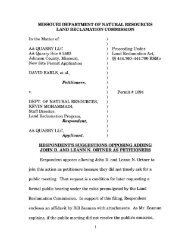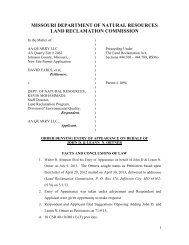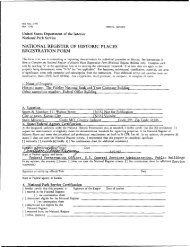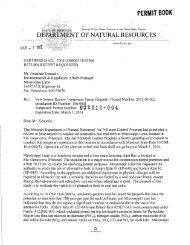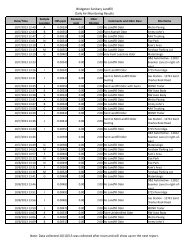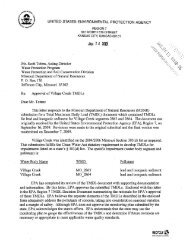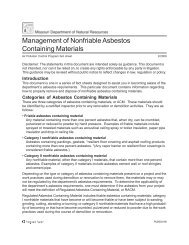Winter 2006 - Missouri Department of Natural Resources
Winter 2006 - Missouri Department of Natural Resources
Winter 2006 - Missouri Department of Natural Resources
Create successful ePaper yourself
Turn your PDF publications into a flip-book with our unique Google optimized e-Paper software.
esource stations learning about aquatic<br />
ecology, cultural landscapes, forestry, soils,<br />
land use and wildlife.<br />
They pored over a stream display that<br />
taught them about the impacts <strong>of</strong> erosion.<br />
They studied maps and learned about watersheds.<br />
They knelt in soil pits, walked in the<br />
woods, and carefully examined stalks <strong>of</strong><br />
Sericea lespedeza, learning ways to identify<br />
<strong>Missouri</strong>’s soils, trees and invasive species.<br />
The students also learned about various<br />
types <strong>of</strong> cultural resources, and ways in<br />
which culture can shape the landscape.<br />
“The Canon Envirothon is a great educational<br />
event for all students … It allows students<br />
who have had no specific interest in<br />
environmental studies before, the opportunity<br />
to see if a career in the natural resources<br />
is something they might want to pursue<br />
later. It also allows them to see how everything<br />
affects everything else,” said Stinson.<br />
The training didn’t stop at day’s end; in<br />
the evenings, students continued to<br />
learn. A tour <strong>of</strong> Fantastic Caverns showed<br />
students what hundreds <strong>of</strong> years <strong>of</strong> percolating<br />
water in the limestone hills <strong>of</strong> the<br />
Ozarks can create. Students learned more<br />
about <strong>Missouri</strong>’s caves and wildlife at the<br />
Wonders <strong>of</strong> Wildlife Museum. Tumbling<br />
Creek cave snails, white-tailed deer, and<br />
other exhibits awaited students at the museum.<br />
They also were able to watch otters<br />
play and enjoyed aquariums twice their<br />
height, teeming with aquatic life.<br />
After two days <strong>of</strong> training on <strong>Missouri</strong>’s<br />
resources, 250 students ventured out for a<br />
day <strong>of</strong> testing in temperatures topping 100<br />
degrees. They examined wildlife pelts, fish,<br />
streams, trees and test questions. Armed<br />
with bottles <strong>of</strong> water and sports drinks, they<br />
proved they were definitely up for the challenge.<br />
Most had started studying resource<br />
materials long before they arrived.<br />
Students found themselves back at the<br />
battlefield one last time Friday morning for<br />
additional cultural resources training.<br />
Dressed civil war attire, Matt Campbell, <strong>of</strong><br />
the National Parks Service, explained what<br />
life might have been like for those in the<br />
battle. Teams were then sequestered for the<br />
rest <strong>of</strong> the evening to work on their oral presentations.<br />
Students spent the evening after<br />
testing in white T-shirts and poodle skirts,<br />
(Opposite page) Matt<br />
Campbell, <strong>of</strong> the National<br />
Parks Service, fills the barrel<br />
<strong>of</strong> a gun with gunpowder,<br />
while students from the<br />
Manitoba Envirothon team<br />
look on. Campbell, dressed<br />
in Civil War attire, explains<br />
what life might have been<br />
like for those fighting in the<br />
battle that took place at Wilson’s<br />
Creek National Battlefield<br />
in 1861.<br />
(Left) Aimee Davis, <strong>of</strong> the<br />
winning Pennsylvania team,<br />
shares her surprise and excitement<br />
with teammates.<br />
(Bottom left) Delaware students<br />
make their final oral<br />
presentation on managing<br />
cultural landscapes. The<br />
top five teams do a final<br />
oral presentation in front <strong>of</strong><br />
a panel <strong>of</strong> Envirothon<br />
judges and other teams.<br />
(Bottom right) Quayle Chew<br />
(right), Lance Pflieger, Jay<br />
Houtz (back) and Rachel<br />
Simmons (left), <strong>of</strong> the Utah<br />
team, practice identifying<br />
aquatic insects during training<br />
at Fantastic Caverns.



